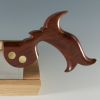Would the Woodmizer, etc. sawmill be able to flatten one side or even both? The one I operated could take lengths down to 48" and, IIRC, could go as low as 6/4 thickness. Shims underneath could bring the slab to the right level. The low dogs along the rails would keep it laterally table. I can envision a base built for milling a few slabs that would allow blocks and wedges to be nailed in place to stabilize underside of the piece. Do you have band sawmill nearby?
Rustic? Well, no. That was not my intention!




 Reply With Quote
Reply With Quote





